
OKRA RECIPES FROM AROUND THE WORLD
07/17/20 — Ada Broussard
Okra plants are related to hibiscus and cotton plants with tropical looking flowers that scream of an equatorial evolution. The earliest known evidence of okra cultivation comes from Ethiopia. Egyptian cultivation of the crop was common by the 12th century B.C., and okra became a prevalent crop in North Africa and the Middle East where the plant could stand up to the hot temperatures. Okra seeds traveled to India along trade routes and to the Caribbeans and Americas via the slave trade, and today, the young seed pods are harvested and chopped up all around the world. There are even Greek and Turkish dishes that celebrate the pods (both regions that used to be under Ottoman control). Caffeine-free coffee alternatives are made with the roasted seeds, and scientists are studying okra slime as a means to make biodegradable food packaging.
![]() Okra in hand. Photo by Scott David Gordon.
Okra in hand. Photo by Scott David Gordon.
Okra’s “mucilage”, or the slime factor, is an inherent quality of the vegetables. Roasting the pods whole in a very hot oven can minimize the slime, but really, okra is slime. In fact, this slimy quality is often wielded as an advantage, used to thicken soups and stews. Okra is as polarizing as cilantro and is a take-it or leave-it vegetable for many. If you’re on team “take-it” but are growing weary of your usual okra dishes, we’ve got a few recipes from around the world to spice up your okra experience. Disclaimer: what you won’t see below is a fried okra recipe because we’re working off the assumption that you’re already doing this. If not, better hurry. This peculiar and unique pod won’t be around forever!
![]() Swimming (JBG) okra. Photo by JBG recipe developer and food photographer, Mackenzie Smith.
Swimming (JBG) okra. Photo by JBG recipe developer and food photographer, Mackenzie Smith.
Gumbo: The word gumbo is actually a derivative of a West African word for okra, and in many Créole gumbo recipes, okra is a main ingredient used to thicken the stew. If you ask us, it’s a big hot for gumbo at the moment. Do your future self a favor, and chop, blanch, and freeze your next clamshell of JBG okra. It will be waiting for you just in time for the first cold snap of the fall, sitting next to your popsicles and cheering you along through the hot, hot summer.
![]() Okra leaves and flowers, reaching for the sky. Photo by Scott David Gordon.
Okra leaves and flowers, reaching for the sky. Photo by Scott David Gordon.
Bindi Masala: This is an Indian dish of cooked okra (or "ladyfingers") with toasted spices, and sometimes other vegetables like onions and tomatoes. If you like Indian cuisine and haven’t dabbled into the world of Youtube tutorials on popular Indian dishes, buckle up. There are so many wonderful home cooks sharing their recipes on Youtube. Here is just one of many videos we found for bindi masala. We checked in with our operations manger, Krishna, to see if he had any tips for making bindi masala at home. He said that you can eat bindi masala as a side dish, or can even roll the okra stir fry in a tortilla (which should probably be heated and brushed with ghee ) .
![]() Green okra, ready to roll. Photo by Scott David Gordon.
Green okra, ready to roll. Photo by Scott David Gordon.
Bamya: Tomatoes and okra both come into season during the same hot moments every summer and so it should be no surprise that many okra recipes from around the world pair acidic tomatoes with silky (slimy?) okra. The two just go together. Bamya, the word for okra in Arabic, is also the name of an Egyptian okra and tomato stew , often containing lamb or beef, and sometimes served with spaghetti noodles! Unlike the 2-5 (sometimes 6!) inch okra that you’ll often find in the United States, okra in other parts of the world are harvested when they’re so tiny - shy of even an inch! Baby Bamya!
![]() Bulk okra at market.Must be summer! Photo by Scott David Gordon.
Bulk okra at market.Must be summer! Photo by Scott David Gordon.
Maafe: Maafe is the word for a West African peanut (or groundnut!) stew, of which there are many, many variations, some involving proteins like beef or chicken, and some involving vegetables like tomatoes, corn, and the pod of the hour: okra. Whereas so many okra recipes lean on the acid side (thank you, tomatoes), this stew envelopes okra in a creamy and rich sauce that will surely be an okra expedition for many. This recipe from the blog Chocolate for Basil seems like a great starting point to these West African flavors.
![]() Okra pods have tiny hairs that can irritate the skin after a prolonged period of harvesting. Thankfully, there is an easy solution: gloves. Photo by Scott David Gordon.
Okra pods have tiny hairs that can irritate the skin after a prolonged period of harvesting. Thankfully, there is an easy solution: gloves. Photo by Scott David Gordon.
Okra Ohitashi: Cold, marinated okra might be your next favorite way to enjoy this vegetable. Ohitashi refers to a Japanese dish that is, most simply, a blanched vegetable soaked in dashi, or a Japanese umami-rich broth made a number of ways, depending on the type. Making a simple dashi at home is easy, and blanching okra is literally as easy as boiling water. We love this recipe for okra ohitashi and the gateway it provides to ohitashi of all types. CSA Members, take note! Here is a gateway cooking technique with endless seasonal variations!
![]() If consistently picked, okra plants will continue to grow tall, all season long, with the fresh pods emerging at the top of the strong stalk. Photo by Scott David Gordon.
If consistently picked, okra plants will continue to grow tall, all season long, with the fresh pods emerging at the top of the strong stalk. Photo by Scott David Gordon.
Coconut Okra Rice: We thought we were done suggesting okra recipes until we stumbled upon this recipe from The Caribbean Pot which makes a rice pilaf, of sorts, with okra and coconut milk. This recipe calls for a medley of peppers, both hot and sweet, making it a perfect one-pot summer dish to show off some seasonal veg.
Go forth, and okra!
 Okra in hand. Photo by Scott David Gordon.
Okra in hand. Photo by Scott David Gordon.
Okra’s “mucilage”, or the slime factor, is an inherent quality of the vegetables. Roasting the pods whole in a very hot oven can minimize the slime, but really, okra is slime. In fact, this slimy quality is often wielded as an advantage, used to thicken soups and stews. Okra is as polarizing as cilantro and is a take-it or leave-it vegetable for many. If you’re on team “take-it” but are growing weary of your usual okra dishes, we’ve got a few recipes from around the world to spice up your okra experience. Disclaimer: what you won’t see below is a fried okra recipe because we’re working off the assumption that you’re already doing this. If not, better hurry. This peculiar and unique pod won’t be around forever!
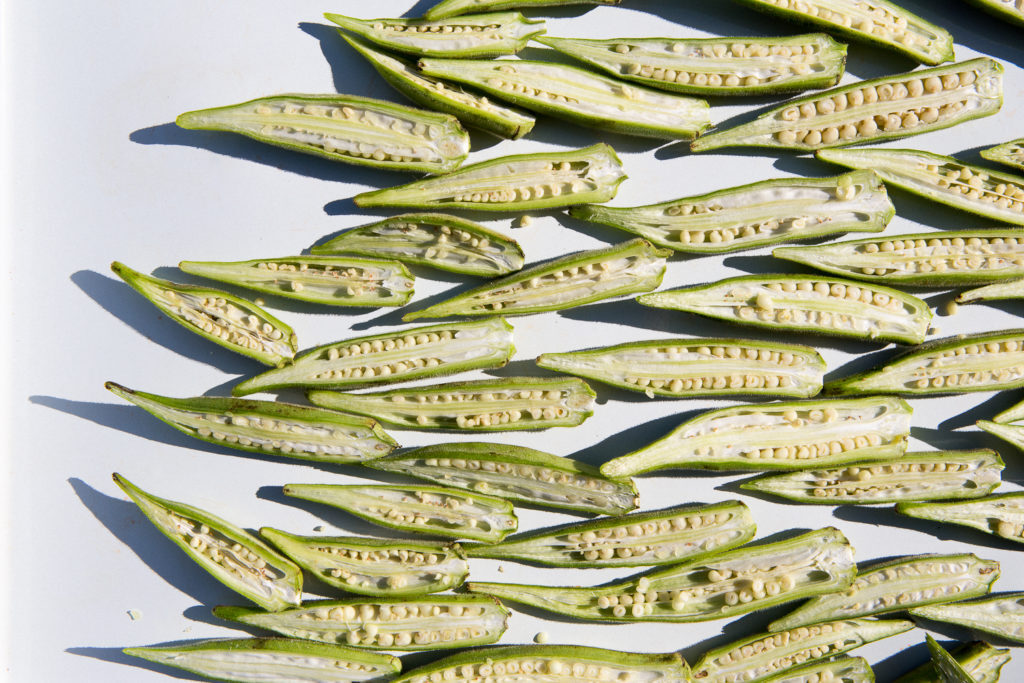 Swimming (JBG) okra. Photo by JBG recipe developer and food photographer, Mackenzie Smith.
Swimming (JBG) okra. Photo by JBG recipe developer and food photographer, Mackenzie Smith.
Gumbo: The word gumbo is actually a derivative of a West African word for okra, and in many Créole gumbo recipes, okra is a main ingredient used to thicken the stew. If you ask us, it’s a big hot for gumbo at the moment. Do your future self a favor, and chop, blanch, and freeze your next clamshell of JBG okra. It will be waiting for you just in time for the first cold snap of the fall, sitting next to your popsicles and cheering you along through the hot, hot summer.
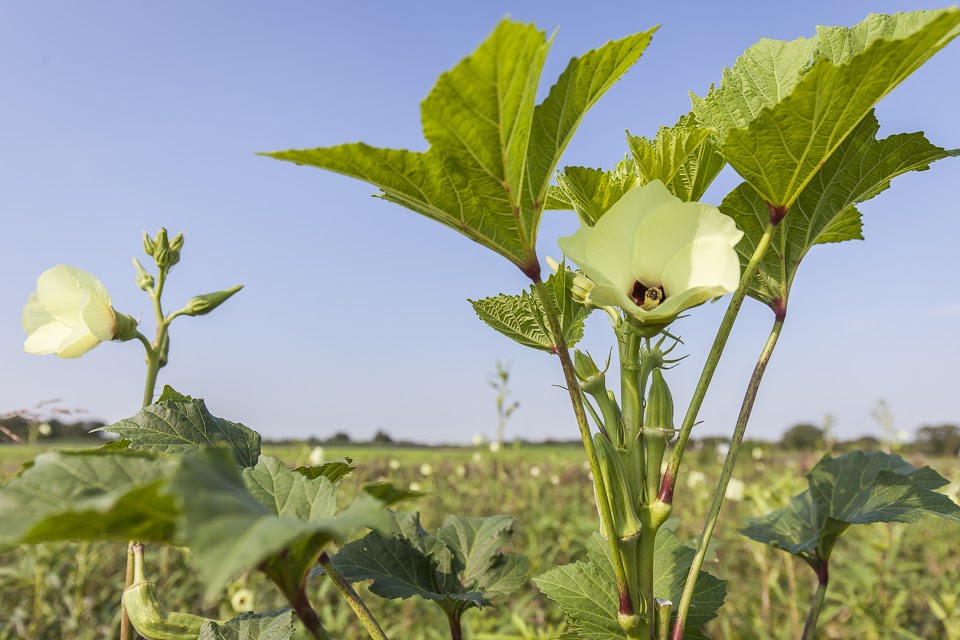 Okra leaves and flowers, reaching for the sky. Photo by Scott David Gordon.
Okra leaves and flowers, reaching for the sky. Photo by Scott David Gordon.
Bindi Masala: This is an Indian dish of cooked okra (or "ladyfingers") with toasted spices, and sometimes other vegetables like onions and tomatoes. If you like Indian cuisine and haven’t dabbled into the world of Youtube tutorials on popular Indian dishes, buckle up. There are so many wonderful home cooks sharing their recipes on Youtube. Here is just one of many videos we found for bindi masala. We checked in with our operations manger, Krishna, to see if he had any tips for making bindi masala at home. He said that you can eat bindi masala as a side dish, or can even roll the okra stir fry in a tortilla (which should probably be heated and brushed with ghee ) .
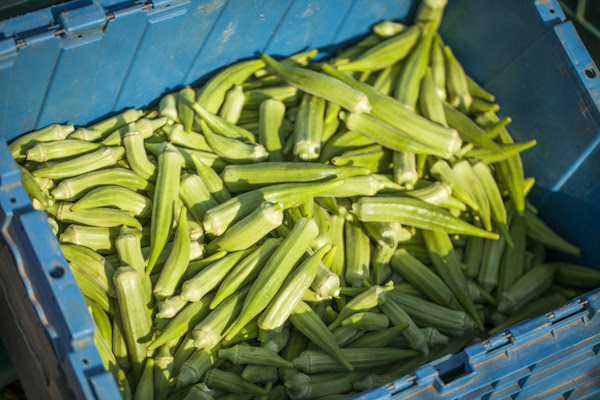 Green okra, ready to roll. Photo by Scott David Gordon.
Green okra, ready to roll. Photo by Scott David Gordon.
Bamya: Tomatoes and okra both come into season during the same hot moments every summer and so it should be no surprise that many okra recipes from around the world pair acidic tomatoes with silky (slimy?) okra. The two just go together. Bamya, the word for okra in Arabic, is also the name of an Egyptian okra and tomato stew , often containing lamb or beef, and sometimes served with spaghetti noodles! Unlike the 2-5 (sometimes 6!) inch okra that you’ll often find in the United States, okra in other parts of the world are harvested when they’re so tiny - shy of even an inch! Baby Bamya!
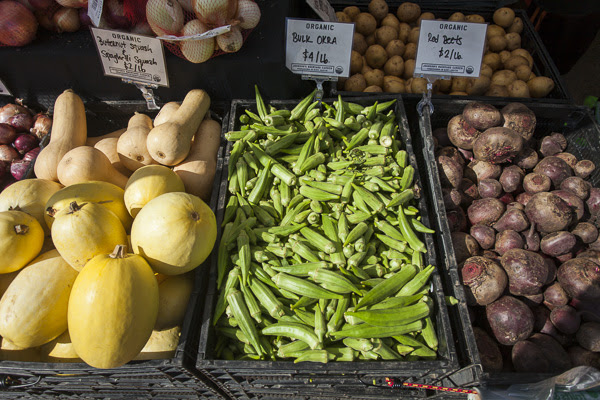 Bulk okra at market.Must be summer! Photo by Scott David Gordon.
Bulk okra at market.Must be summer! Photo by Scott David Gordon.
Maafe: Maafe is the word for a West African peanut (or groundnut!) stew, of which there are many, many variations, some involving proteins like beef or chicken, and some involving vegetables like tomatoes, corn, and the pod of the hour: okra. Whereas so many okra recipes lean on the acid side (thank you, tomatoes), this stew envelopes okra in a creamy and rich sauce that will surely be an okra expedition for many. This recipe from the blog Chocolate for Basil seems like a great starting point to these West African flavors.
 Okra pods have tiny hairs that can irritate the skin after a prolonged period of harvesting. Thankfully, there is an easy solution: gloves. Photo by Scott David Gordon.
Okra pods have tiny hairs that can irritate the skin after a prolonged period of harvesting. Thankfully, there is an easy solution: gloves. Photo by Scott David Gordon.
Okra Ohitashi: Cold, marinated okra might be your next favorite way to enjoy this vegetable. Ohitashi refers to a Japanese dish that is, most simply, a blanched vegetable soaked in dashi, or a Japanese umami-rich broth made a number of ways, depending on the type. Making a simple dashi at home is easy, and blanching okra is literally as easy as boiling water. We love this recipe for okra ohitashi and the gateway it provides to ohitashi of all types. CSA Members, take note! Here is a gateway cooking technique with endless seasonal variations!
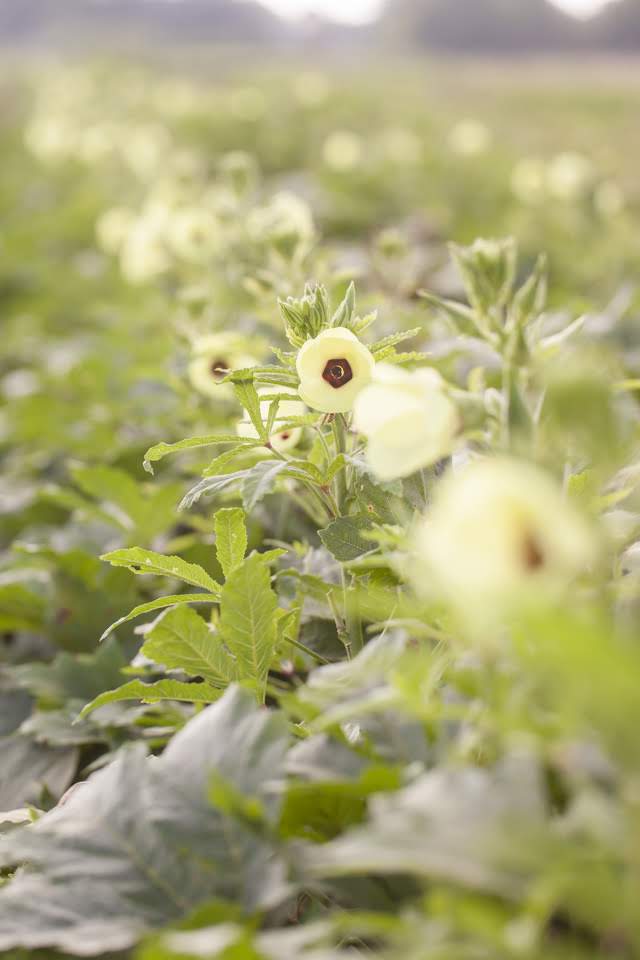 If consistently picked, okra plants will continue to grow tall, all season long, with the fresh pods emerging at the top of the strong stalk. Photo by Scott David Gordon.
If consistently picked, okra plants will continue to grow tall, all season long, with the fresh pods emerging at the top of the strong stalk. Photo by Scott David Gordon.
Coconut Okra Rice: We thought we were done suggesting okra recipes until we stumbled upon this recipe from The Caribbean Pot which makes a rice pilaf, of sorts, with okra and coconut milk. This recipe calls for a medley of peppers, both hot and sweet, making it a perfect one-pot summer dish to show off some seasonal veg.
Go forth, and okra!






 0 ITEMS IN CART
0 ITEMS IN CART 

